Frida’s biography, endless bitterness on the canvas
In the last part of the previous article ” Who is Frida Kahlo ” in Maryam Mansouri Blog, we went so far as to say that young Frida Kahlo was separated from her previous fiancé and that all she had was sadness, pain, and, of course, painting. Having left behind strange stories and, of course, death, she now had the opportunity to paint all his pain on canvas.
She had found painting as his only constant companion, and now painting had become one of her main priorities. stay with us to talk about Frida Kahlo biography.
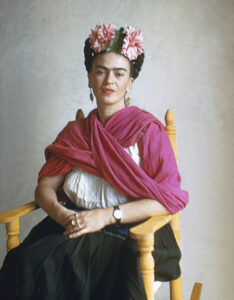
As mentioned in the previous episode, Alejandro left her after the accident. Frida had painted many paintings in those years, all of which were surprisingly attractive and spectacular, and the answer to this fascination was in Frida’s bitter days. Frida’s writing in those days coincided with the creation of innovative works, all of which reflected the events of Frida’s previous years.
The relative calm of 1928 promised great things for Frida Kahlo, and ironically it did. Having reduced her level of physical pain a little and was recovering, she decided to take her works, mostly in the form of self-portraits, to Diego Rivera. Mr. Rivera was a great Mexican muralist and a communist activist who also had a brief acquaintance with Frida.
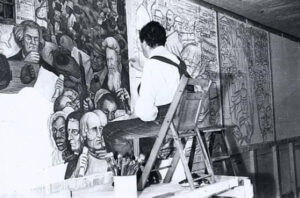
The story of Rivera and Frida dates back to the high school years. Rivera went to Frida’s school in those years and worked on a large mural.
Young Frida in those days was excited to see Diego Rivera painting and even told one of her friends that one day she would finally have a child with Diego Rivera! She spent hours watching Diego, and now, several years later, she had the opportunity to bring her paintings to him.
Diego Rora was thrilled to see Frida’s paintings and showed great enthusiasm for them because Frida’s paintings were very special and unique at that time. This is how Diego and Frida decided to increase their relationship, and this meeting and, of course, Frida’s unique painters paved the way for the beginning of their relationship.
Frida Kahlo’s marriage and side effects
Marriage is one of the important events in Frida Kahlo biography. In 1929, Frida Kahlo and Diego Rivera decided to get married. Frida’s marriage was extraordinary for everyone in those days because Diego was 42 years old and Frida was only 22 years old! In the meantime, the opinion of Frida’s mother, who was very opposed to Frida’s marriage, was fascinating. She had said in this regard that:
they are like elephants and cuckoos
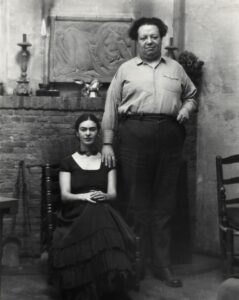
But Frieda, a professional lover, did not owe her a word in those days, and her intense feeling for Diego made her a first-rate fascinator. Every single one of Frida’s cells in those days was focused on loving Diego, and this made Frida so happy that her description was difficult and, to a large extent, strange to anyone. It is better to forgive us for writing about this and focus your attention on Frida’s opinion about her marriage to Diego:
The day finally came when I showed my paintings to the great Mexican painter. Diego admired art. In an instant, I felt the beauty of my being, and now I was in love with Diego, and Diego Rivera was in love with me! As the days passed, I took Diego with me, and Diego included me in his paintings. I became a socialist, and Diego fell in love. Mr. Rivera, the great Mexican painter, is my wife. I am happy. Now, I just want to have a child from Diego.
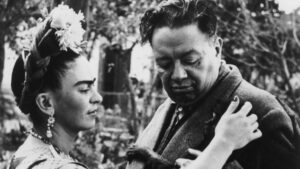
These sentences well express the feelings of those days, and of course, the important point, in this case, is the last part of his quote, the claim that was related to having a child.
It is challenging to describe these days of Frida, and there are many sayings and hadiths about this, know that Frida experienced the absence of two things in the continuation of her life with Diego:
Happiness and children…
This was perhaps the bitterest response of the day to a girl who thought she was happy and would have a child. He did not have either.
The first years of Frida life with her husband
In the early years of Frida Kahlo’s marriage to her husband, Diego, the two experienced good days full of travel. Diego was Frida’s primary motivator for painting, and they admired her work. The two went on missions together in those years, related to the work of Diego Rivera and related to different cities.
impact of Diego’s work missions on Frida Kahlo’s life
Diego was one of the most influential people in Frida Kahlo’s biography. In 1930, they moved to San Francisco, which was certainly not a good place for a communist couple. This caused many problems for Frida and Diego in those years.
The artistic couple then traveled to New York City for the Rivera Exhibition at the Museum of Modern Art. They stayed for a while before being forced to relocate to Detroit on Rivera’s mission with the Detroit Institute for the Arts.
In 1933, the lives of Frida Kahlo and Diego Rivera in New York City were met with much controversy over their communist nature. The culmination of these events was when Rivera worked on a project for Nelson Rockefeller called Man at the Crossroads. The mural was to be painted at the RCA building in Rockefeller Center.
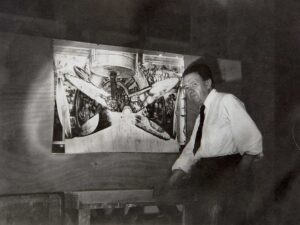
During this painting, Rivera made a gesture that resembled a portrait of the devil in heaven. Diego Rivera painted a portrait of Vladimir Lenin, the communist leader and, of course, the number one enemy of American politicians.
Rockefeller stopped the project, and later another painting was painted on it to be forgotten. But the story went further than that and made things difficult for Diego and Frida.

The controversial artistic couple returned to Mexico a few months later and lived together in San Angel.
Frida Kahlo children
Everything was good in the United States after the controversy, and the good news was coming;
Frida was pregnant and not far from becoming a mother and having a child with Diego Rivera. But this happiness did not last long, and in 1934 she was forced to have an abortion, and Frida’s dreams were dashed.
Frida’s accident in her youth and the bar that broke the tension had deprived her of having a child forever. It was as if this accident was supposed to torment his soul forever and destroy him bit by bit.
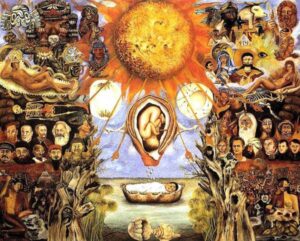
This caused more distance between him and Diego and affected their married life. The aftershocks of Kahlo and Rivera cohabitation coincided strangely with World War II.
The gradual fall of Frida’s life into the depths of sorrow
During these years, Europe, which should have been the cradle of European art, was burning in the war. Many artists were migrating to Latin America due to these events, what better place than Mexico City!
Thus, the house of Frida Kahlo and Diego Rivera in those years had become a unique hangout for fugitives and exiles who were mainly left-wing.
These upheavals and hesitations between Diego Rivera and Frida Kahlo paved infidelity and strange relationships.
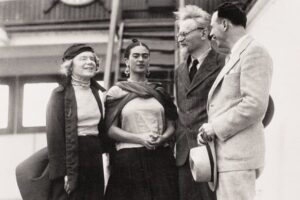
During these years, the footprints of celebrities such as Leon Trotsky, Pollet Godard, Isamu Noguchi, and Josephine Baker were also seen in these strange relationships, all of which resulted from a strange incident between Frida and Rivera that reduced Frida Kahlo to ashes. We will describe this later, but before that, it is better to talk a little about Mr. Rivera’s record in marriage and married life.
Frida’s wife’s relationship with other women
Regarding Frida Kahlo’s biography, we must say that Frida was Diego’s third wife. Although Diego was a very good and successful man in art and communism, he was by no means a trustworthy person in marriage, and a galaxy was far from the ideal man of the family. He constantly betrayed his wives and left a terrible record in this field, and naturally, for a man like her, Frida was no exception.
Frida Ashegh knew that he was in contact with other women, but he never did because he did not want to give up his love for Diego, and he prepared the ground for a heavy and final emotional blow to Frida.
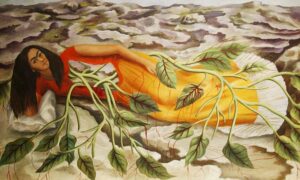
The culmination of the tragedy was when Frida found out that Diego was having an affair with her sister, and this led to Frida’s free fall to the bottom of grief and a terrible defeat. A failure that was also reflected in Frida’s paintings.
Dfrida kahlo divorce
In 1938, Frida cut her long black hair and took a self-portrait of the famous post-betrayal portrait, in which she was sitting on a chair with scissors in her hand and a suit, and she cut all her hair short and spread it on the floor.
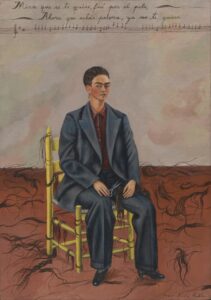
Of course, due to the strange events in Frida’s life, this separation did not last long, and Frida and Rivera remarried in 1940.
After the separation, Frida painted her painting while holding her hand and said about this painting:
Diego is no longer with me, and I let him go. Now I am myself. I draw. This time I will kill myself. Hand in hand, I married myself. Am I enough for myself?

Now that we are talking about Frida’s works, it is better to look at Frida’s artistic style.
Frida Kahlo’s painting style
With a bit of research, even unprofessional people realize that Frida’s face is at the center of most of her work. Her solid technique for illustration and composition, along with her unique taste in the use of colors, has brought the faces of Frida on canvas, which shows her great sorrow and suffering.
In the self-portraits, his eyes are locked with a hard look at the audience, expressing a past that is quite bitter and sad.
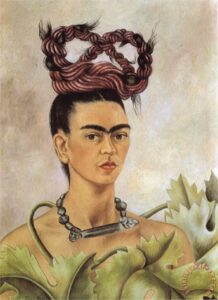
During her artistic career, Frida painted 143 paintings, in which 54 self-portraits shine. Kahlo’s portraits are always imbued with the concepts of his personal life and his past events. These self-portraits often describe events that happened to him.
Symbols of Frida’s works
In some self-portraits, household and decorative objects are skillfully placed in frames, and animals are used in the best way in Frida’s works. For example, in Frida’s works, black monkeys and cats are seen wrapping their hands around Frida’s neck and staring at the audience’s eyes, just like Frida
Frida also uses plants skillfully in her paintings. For example, in one of his works, large and thick plants in the painting frame contain tension and refer to the unfortunate moments in which they do not leave Frida’s suffering.
In some of the paintings, Frida draws flowers with vivid colors and are full of energy, but life and vitality are not seen in them, and they are entirely dead. In one of the paintings, these dead flowers are placed between Frida’s hair.
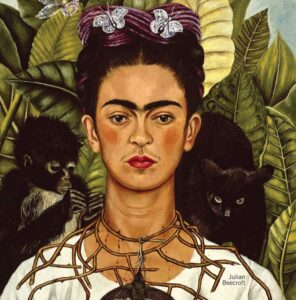
Frida paints a strange picture of herself in “The Thorn and the Hummingbird Necklace.” He has painted himself holding a necklace of thorns around his neck, and a pendant in the shape of a dead hummingbird adorns the necklace.
The painful and, of course, thought-provoking point of this self-portrait is the monkey who is seemingly intimate with Frida and is amicably pulling this necklace. The monkey, a classic symbol of death in Mexico, tries to make Frida suffer annoyingly as if trying to add to Frida’s pain. The Hummingbird is also a spell in classical Mexican literature for success in love and happiness; you may ask where success is in love, and Frida ?! Frida has answered this question in painting! A cat on Frida’s shoulder is lurking in a hummingbird. This painting is one of Frida’s most significant paintings.
The endpoint, Frida’s release
Frida Kahlo, one of the leading female painters in the art world, passed away one of the first days of her 47th birthday. On January 13, 1954, the ill and lethargic Frida Kahlo died in her beloved Blue House after a long and painful war of endless grief, leaving the art world alone with her exceptional paintings.
Frida was a unique artist who had a madness of pain in her tongue. Frida was amazing in her time and was not associated with the normal flow of art. But it’s a pity that the talented Frida did not have much time for her adventure and flourishing, and her illness ended.
Of course, Frida’s death is always a place for discussion about her. According to some speculations about his death, there are several different scenarios, each of which has challenged the nature of his death.
Some say that the cause of the death of Frida was a pulmonary embolism, while others say that the blockage of blood flow was the cause of her death. It is clear from these comments that Frida’s death has always been the subject of controversy among experts, and many stories have even been told about the possibility of Frida’s suicide.
But looking at history, we find that some of Frida Kahlo’s illnesses were not unique to her and that some of Frida Kahlo’s health problems in the 1950s were almost epidemic at the time.
Gangrene is one of the diseases that Frida and many others were affected by. In this case, Frida was forced to spend nine months in bed after being diagnosed with gangrene in her right leg. During his hospitalization, he also underwent several different surgeries to eliminate and fight infections in his body.
Despite being extremely ill and unable to move, he did not stop his artistic, political, and social activities and continued his brilliant works.
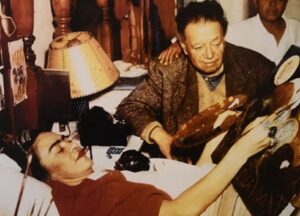
Following the series of Frida Kahlo’s illnesses and helplessness, in 1953, doctors told Frida that her right leg was in poor condition and would have to amputate part of Frida Kahlo’s right leg. Frida’s right foot was more susceptible to disease and infection and may have provided the basis for the spread of gangrene. As a result, her leg was amputated, and new pain was added to Frida’s collection of pain.
Frida really had no reason to be happy now and was deeply depressed. Meanwhile, his general condition and health were deteriorating, and he had to be hospitalized again in early 1954 due to physical problems.
Of course, some say that the reason for Frida’s hospitalization, in addition to her illness, was her suicide attempt. Apart from these arguments, Frida’s soul was in utter persecution, and disease had destroyed her spirit.
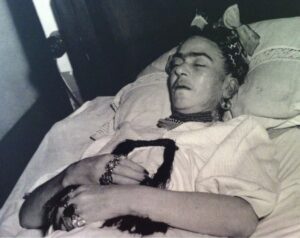
As we said at the beginning of this section, Frida Kahlo finally died on July 13, 1954. Her ashes are now in a jar in her childhood home, or Blue House, the Frida Kahlo Museum. A very interesting point about his death is a note he wrote a few days before his death:
I hope the departure is enjoyable, and I hope I never return.
She left, but his memory and his paintings will live on in the hearts of art lovers forever.
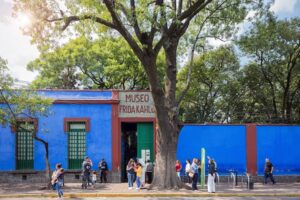
In the end, we hope you enjoy the article on Frida’s life and works, the endless bitterness on the canvas.







